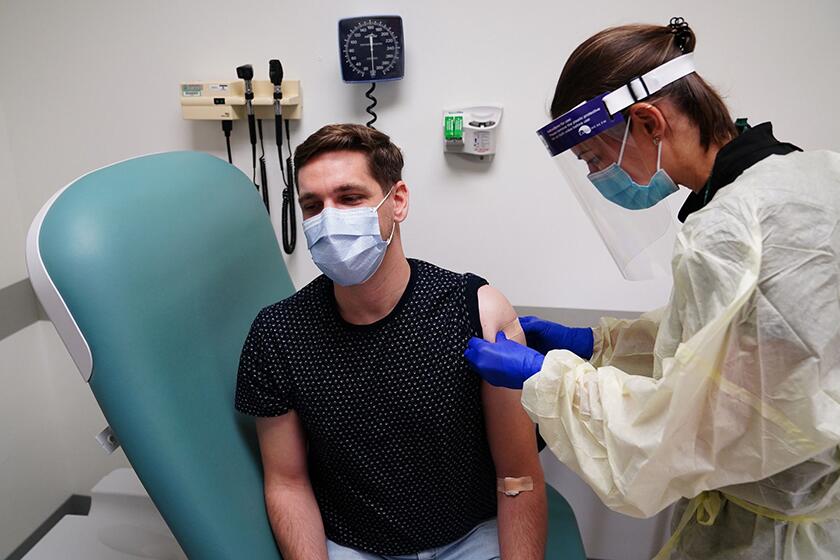La Plaza de Cultura y Artes’ rocky start
- Share via
Long before the April opening of La Plaza de Cultura y Artes, the new downtown museum and event space, there were problems. It took years for Los Angeles County Supervisor Gloria Molina to acquire the land for her prized project, a cultural center dedicated to the history of Mexicans and Mexican Americans in Los Angeles. Then there was the task of renovating the dilapidated landmark buildings to house the center. Finally, there was an uproar when the fragile remains of more than 100 settlers of Los Angeles — including Native Americans — were discovered and removed before construction crews, hurrying to finish the project, were halted.
La Plaza, near historic Olvera Street, may be better known for its problems than for its exhibits. And that’s too bad. Because there’s much to see and — even better — touch within the gleaming walls of the restored buildings. The inaugural show, “LA Starts Here!,” tracks the history of the pueblo of Los Angeles in an artful array of timelines, historic photographs and objects: a silver writing set, guns, the shawls of Doña Maria de Jésus Yorba de Scully. A replica of 1920s Main Street allows visitors to wander in and out of storefronts, smelling herbs in the farmacia and trying on hats in a clothing shop. A high-tech photo booth allows visitors to record brief videos of their own histories and plug them into “Community Voices,” one of the touchscreen computer mosaics mounted on the museum’s walls. Almost everyone who visits makes a video, says senior curator Cindi Dale.
Last spring, La Plaza’s then-chief executive, Miguel Angel Corzo, said: “Two million people come to Olvera Street every year. If they cross the street, they will enter a place where they can get a better understanding of Los Angeles.” But they haven’t crossed the street, and Corzo has left under a shadow. His contract was not renewed after an examination of the books indicated he had mismanaged the project, according to Molina.
Now, La Plaza has serious financial problems. Although a hefty infusion of more than $32 million from the county — $14 million of it from Molina’s discretionary funds — was designated for construction and expenses, the contractor recently filed a $5.2-million lawsuit against La Plaza and Los Angeles County for nonpayment, the staff has been cut by half and fundraising by the center’s board has been lackluster.
La Plaza officials estimate that the museum has had about 39,000 visitors — many of them schoolchildren and teachers — since it opened. Only 4,052 were paid admissions, according to the center’s records. That percentage is not unusual. Even for big museums, paid admission is a tiny fraction of the institutions’ revenues. But La Plaza needs more visitors and more private funds.
New executives have been hired to draft a new development approach. However, there are some built-in hurdles the center must clear if it wants to compete for visitors with the region’s other attractions — museums, shopping centers, the beach, the L.A. Zoo, Disneyland. La Plaza needs to build up a membership base. The current exhibition of objects, all on loan from collectors and institutions, is slated to stay up through the end of 2012. That’s fine, but without a regular change of exhibits, La Plaza loses one easy incentive for patrons to become members and visit frequently.
A greater variety of programming would attract more people. La Plaza officials have always said that the center was more than a museum and would feature music performances, films, lectures and garden tours on the manicured grounds. Those kinds of events are only beginning to be scheduled. Officials should concentrate on planning more of them.
Above all, museums live or die by fundraising. This year’s allotment from the county — $1 million for maintenance, insurance and utilities — will not alone keep La Plaza alive. Although the county has a public-private partnership with the center — as it does with several cultural institutions — we believe the cash-strapped county government should be looking for ways to minimize financial obligations like this, not take on new ones. Upkeep should be the responsibility of the private sector.
La Plaza officials must direct the members of their board to court donors more aggressively and to contribute substantially themselves — or add other board members who can help with this vital task. The center, to its credit, has already secured a commitment from PepsiCo to donate $1 million over three years.
There were many problems getting La Plaza built. Keeping it open will be just as challenging.
More to Read
A cure for the common opinion
Get thought-provoking perspectives with our weekly newsletter.
You may occasionally receive promotional content from the Los Angeles Times.









